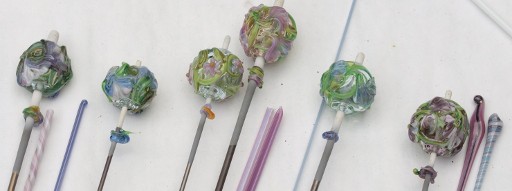If you've ever wondered how people come up with ideas for their pieces, here's an example. Reading through these notes will give you a pretty good idea of my working methods for developing canes. —Note that there's a lot of false starts, semi-bad results, etc. It's basically an iterative process, refining out the useable bits till they all work together. Since I recently gave a demo to my guild on this topic, (but didn't have a lot of time to discuss design theory) I dug this post out of vault, where it's been patiently waiting for, oh, not quite three years.[1]

today's efforts. The highest one in the middle was made last, which sort of confused me at the time. Click on the image to get a bigger version, so you can see the canes better.
Not shown: round hollow! the secret to making these is to make a short fat cylinder & round up. So the holy grail being a petal with a center strip of opaque, edges clear, overlain with opaque (white) stripes.
Bead #1: purplish cane is sky blue heavily cased with dark trans purple, striped with lt opq pink (?), w/ 2 strips of periwinkle inbetween, and mebbe cased with pale aqua overall...?
Bead #2: blue cane is medium cobalt, striped first with white, then dark (but trans) purple in between. "White" is mostly white twistie with hint of purple (shown to left of bead.)
beads #3 & 4: Ok, mebbe these are the ones with the periwinkle bands.
bead #6: note twistie—made by twisting cane to immediate left—white core (with a bit of opq grey & turq) overlain with stirpes of gold ruby, black, 254, asst dk trans blues. When twisted, becomes mostly white. So far, this has given the best effect.
Obviously lots of work & testing to figure out following factors:
- core: trans or opq?
- ratio of casing to core
- whether opq stripes cased or not (mostly appear to be not)
[1]I probably wanted a clearer ‘end’ to the story. But frankly, finding perfect cane is kind of a never-ending quest anyway, because no matter how many good recipes I have, I always want more.
Unless otherwise noted, text, image and objects depicted therein copyright 1996--present sylvus tarn.
Sylvus Tarn